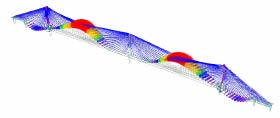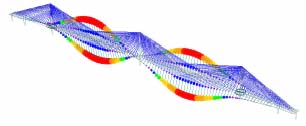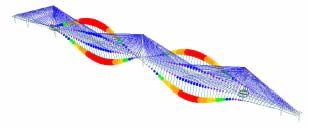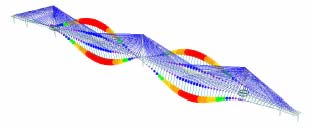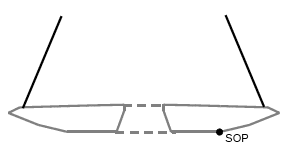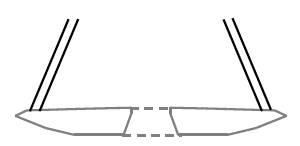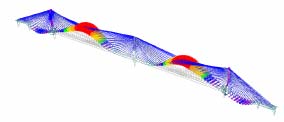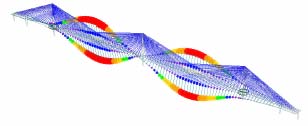5. Assessment of Deck Type Options 5.1 Single Box Girder 5.2 Twin Box Girder 5.3 Ladder Beam
5. Assessment of Deck Type Options
This section is also available in pdf format (1.5mb)
5.1 Single Box Girder
The single box girder deck type is applicable to either the Two Corridor or the Single Corridor functional cross section. The deck arrangements which have been considered are illustrated in Drawings FRC/C/076/D2M/101 and FRC/C/076/D2M/131 in Appendix D.
5.11 Two Corridor Option

(a) Construction material
Both orthotropic and composite variants are considered.
(b) Tower type
Mono-Tower
(c) Stay cable arrangement
As for the Needle Tower studied for the original Scheme Assessment, the stay cables are anchored in the structural zone reserved for the tower - in other words in the ‘shadow’ of the tower. The advantage of this is that no additional deck area is required for the stay anchorages as well as an overall simplification of the fabrication by anchoring the stays away from the shallow edge of the box. However, this does mean that the stay cables provide less torsional support to the deck than if they were connected in a more traditional manner close to the deck edge.
To compensate for the reduced torsional support a box girder deck is required. This provides the necessary torsional stiffness to achieve aerodynamic stability and prevent unacceptable twisting under eccentric traffic loading.
Bridges with stay cables anchored along the centreline of the bridge are reasonably common. When that is the case, no torsional support is provided by the stays themselves and the torsional behaviour of the deck is governed only by its own torsional strength and stiffness. The Tsurumi Tsubasa Bridge with a centre span of 510m is believed to currently have the longest cable stayed span of this type in the world.
Although the span of the Forth Replacement Crossing will be longer than the Tsurumi Tsubasa Bridge, it is proposed that the stay cables are not anchored exactly on the centreline and studies have been carried out which show that the two planes of stays contribute slightly to the torsional stiffness of the bridge.
Nevertheless, the torsional behaviour of the bridge is important and the issues which have been considered are:
- Twist of the bridge under out of balance live load (serviceability issue)
- Torsional shear stresses in the deck
- Transfer of torsional shear from steel to concrete (composite option)
- Aerodynamic stability
(d) Articulation
The deck articulation is as follows:
- Central Tower – monolithic connection
- Flanking Towers – floating system with lateral bearings and vertical buffers
- Side Span Piers – guided bearings
- End Piers – guided bearings
The monolithic connection of the central tower provides a maintenance free torsional connection without concerns related to uplift that would be associated with providing bearings. Longitudinal loads due to wind and braking will also be transferred between deck and tower through the monolithic connection. The monolithic connection has to transfer significant loads and will be designed with a combination of prestressing bars and shear connectors as well as local strengthening of the deck. The detailing of this connection needs to allow construction of the tower to proceed above the connection in advance of mobilisation of the deck erection phase of construction. Additional costs would arise if the main span deck erection plant and labour force were to be mobilised for the erection of this segment alone as the remainder of deck erection would not commence until a number of months after this point. In the event that the units are assembled a significant distance from the site there would also be either a special delivery of this piece alone or storage costs for the remainder of a full delivery.
At the flanking towers a monolithic connection would result in excessive thermal restraint forces and a floating system has been adopted with no longitudinal load transfer between deck and tower. Transverse wind loads are transmitted through lateral restraint bearings. Torsional restraint is provided by vertical buffers as described in detail in Appendix B. For the orthotropic deck the buffers will restrain both static and dynamic torsional movements whereas for the composite deck, which is torsionally stiffer, a simplified buffer arrangement can be adopted which will only restrain dynamic torsional movements but will permit torsional displacements to occur under sustained static forces.
For the guided bearings at the side span piers, uplift is a concern when the main span is loaded. This is a common issue for cable stayed bridges with various solutions available. A number of options have been studied:
(i) Monolithic connection
Building the deck into the piers generates significant sway forces in the piers as the ends of the bridge move with thermal expansion and contraction. With conventional reinforced concrete construction the structural demand is excessive. Use of a steel pier which is more flexible is possible, but the additional cost of this solution is unlikely to be justifiable.
(ii) Uplift bearings
Although bearings can be designed to resist both uplift and downward forces, these bearings are both expensive and prone to noise and wear as there is inevitably some free movement between support of upward and downward load. The magnitude of load in this instance is also outside the range of conventional bearings. Uplift bearings are therefore not considered practical for these reasons.
(iii) Non-structural counterweight
It is possible to place non-structural counterweight within the deck such that no uplift would occur. This option is relatively simple but is not the most economical solution.
(iv) Vertical tie down cables
Vertical tie down cables are a practical solution and would utilise the same technology as the stay cables. The cables would be tensioned to ensure that the bearings remained under compression under all serviceability loading conditions. Under ultimate limit state loads lift off of the bearings could occur but the magnitude of the lift off would be limited by the strain in the tie down cables and the lateral guides of the bearings would remain engaged. The height of the piers provides sufficient length for sway of the tie downs under thermal expansion and contraction of the deck. A cost comparison shows the tie-down to be approximately 25% of the cost of the non-structural counterweight.
(v) Composite deck counterweight
The alternative solution which is available for the orthotropic deck is to change the construction material of the last 150 m of the side spans to composite. The additional weight of the concrete slab would ensure that the bearings remained under compression under all serviceability loading conditions. Under ultimate limit state loads lift off of the bearings could occur but the magnitude of the lift off would be limited by separate restraint brackets and the lateral guides of the bearings would remain engaged. Although in isolation this concrete is more expensive than the tie-down option, the saving resulting from the reduced area of orthotropic steel deck would more than compensate for this.
Both vertical tie-down cables and the composite deck counterweight solutions are practical. The composite deck counterweight option is expected to be more economical for the orthotropic deck since it results in a reduction in the overall steel quantities and is therefore the option taken forward. For the composite deck, tie down cables will be adopted.
Movement joints will be located at piers S2 and N2 at the end of the stay cable fan. This minimises the overall length of the cable stayed bridge structure.
(e) Static serviceability
The static serviceability has been assessed to determine the maximum deflections and twists that could occur in the bridge deck due to traffic load. The twist is the change in transverse gradient of the bridge at mid span. Characteristic values are tabulated below (nominal 1 in 1,000 year return period).
Configuration |
Maximum Deflection |
Maximum Twist |
|---|---|---|
Orthotropic Box |
3,740 mm |
3.5 % |
Composite Box |
2,450 mm |
4.0 % |
The maximum vertical deflection only occurs when one of the main spans is fully loaded and the other is fully unloaded. The chance of this occurring is very low and the maximum deflection is expected to have negligible chance of occurring during the design life of the bridge. The maximum twists occur when one carriageway is fully loaded and the other carriageway has no load on it. This case is more realistic since commuter traffic could realistically result in one motorway carriageway being fully loaded whilst the other carriageway has little or no load on it. However, the maximum twists do assume four lanes of traffic on the carriageway with the heaviest loading in what will be the hardshoulder for the D2M configuration, therefore the twists are only realistic for contra-flow usage. The long return period associated with characteristic loading must also be emphasised – these deflections are not expected on a routine basis.
Serviceability criteria for twist are rarely given in design standards or even project specific design criteria. The criteria for this project need to be established. However, by making reference to the Messina Bridge design criteria a maximum characteristic twist of 5 % is proposed in the draft design criteria for this project.
If vertical buffers were not provided at the flanking towers the maximum twist for the orthotropic deck would increase to 5.1 % which is just above the proposed criterion. Considering this twist assumes four lanes of traffic on a single carriageway, it may be possible to revisit the design criteria and investigate whether the static torsional restraint is really necessary.
(f) Aerodynamic performance
Mode |
Orthotropic Box |
Composite Box |
|
|---|---|---|---|
First Symmetric Vertical Mode |
0.303 Hz |
0.281 Hz |
|
First Torsional Mode |
0.513 Hz |
0.432 Hz |
|
Ratio |
1.69 |
1.54 |
Key dynamic modes
The ratios of the modal frequencies (torsional / vertical) are significantly higher than the provisional minimum target ratio of 1.2 required to avoid coupled flutter vibrations.
Historic wind tunnel tests carried out for the Setting Forth and Second Severn studies indicate a reduced torsional galloping (flutter) velocity of at least 4.5 for an aerodynamic box-girder section with 3.0 m high wind screens. The reduced velocity is a non-dimensional aerodynamic parameter with the following definition:
![]()
Where:
UC is the critical wind speed for the onset of torsional galloping (m/s)
b is the width of the deck (m)
ft is the fundamental torsional frequency of the deck (Hz)
This non-dimensional parameter would indicate the following critical wind speeds, based on a deck width of 41.6 m including the non-structural nosing. These compare to a provisional minimum requirement of approximately 60 m/s.
- Orthotropic Box 95 m/s
- Composite Box 80 m/s
5.1.2 Single Corridor Option

(a) Construction material
Both orthotropic and composite variants are considered.
(b) Tower type
H-Shape Tower (Diamond and A-Frame tower types would also be possible but have not been studied in combination with this deck type – refer to Appendix B).
(c) Stay cable arrangement
For the Single Corridor Option, the stay cables are anchored at the edges of the deck in a conventional manner. Generally this would be expected to provide significant torsional restraint to the deck. However, this deck is considered in combination with the H-Shape tower and as is described in more detail in Section 1.24.2(a), this tower type results in the stay system only providing limited torsional restraint to the centre span region of the deck. Therefore the torsional performance of the deck still requires careful study.
(d) Articulation
The deck articulation is as follows:
- Central Tower – floating system with lateral restraint bearings
- Flanking Towers – floating system with lateral restraint bearings
- Side Span Piers – guided bearings
- End Piers – guided bearings
Despite the limitations of the H-Shape tower, the stays anchored at the edges provide full torsional restraint to the deck at the towers and there is no need for additional torsional restraint to be provided by the bearing system. Therefore a floating system is achievable at all of the towers. This simplifies the tower and deck constructability compared to a monolithic connection.
Longitudinal restraint will still be required. This would be provided either by longitudinal buffers or by introducing substantial guide restraints to the lateral restraint bearings.
Uplift at the side span piers will be resisted in the same manner as for the Two Corridor option, i.e.:
- Orthotropic Box – composite deck counterweight
- Composite Box – vertical tie down cables
(e) Static serviceability
Characteristic values are tabulated below (nominal 1 in 1,000 year return period). Refer to Section 1.19.1(e) for further explanation of the performance data.
Configuration |
Maximum Deflection |
Maximum Twist |
|---|---|---|
Orthotropic Box |
3,900 mm |
3.5 % |
Composite Box |
2,885 mm |
2.6 % |
(f) Aerodynamic performance
Mode |
Orthotropic Box |
Composite Box |
|
|---|---|---|---|
First Symmetric Vertical Mode |
0.346 Hz |
0.274 Hz |
|
First Torsional Mode |
0.570 Hz |
0.514 Hz |
|
Ratio |
1.65 |
1.88 |
Key dynamic modes
The ratio of the modal frequencies significantly higher than the provisional target ratio of 1.2 required to avoid coupled flutter vibrations.
As described in Section 1.19.1(f) historic wind tunnel tests carried out for the Setting Forth and Second Severn studies have been used to infer the following critical wind speeds, based on a deck width of 36.2 m including the non-structural nosing. These compare to a minimum requirement of approximately 60 m/s.
- Orthotropic Box 93 m/s
- Composite Box 83 m/s
5.1.3 Orthotropic Box Deck
The structural details are similar for the Two Corridor and Single Corridor functional cross sections:
(a) Deck structure
The deck is a relatively traditional orthotropic steel box girder. The structural depth is 4.9 m at the bridge centre-line for the Two Corridor option and 4.4 m for the Single Corridor option. The fatigue sensitive top flange plate of typically 14 mm is stiffened at 300 mm intervals by longitudinal trough stiffeners (at 600 mm centres) spanning between diaphragms which are required to maintain the shape of the box and provide the transverse framing. For the Two Corridor option, the bottom flange plate thickness typically varies from 10 to 12 mm and is governed by transverse compression under Special Vehicle loading (equivalent to HB 45 loading in BD 37/01). For the Single Corridor option the transverse forces are tensile and a bottom flange plate of 8 mm is typical. In both cases longitudinal trough stiffeners are provided on the bottom flange at approximately 900 mm centres.
A braced diaphragm is proposed in preference to a full plate diaphragm. Plated diaphragms typically contribute about 20 % of the weight of the deck structure, although this percentage increases as the box gets deeper. For a box which is over 4 m deep a braced truss diaphragm will have the advantages of weight saving and better internal access within the deck. It is considered to be more economic, despite the additional support arrangements required during the assembly process.
For the Two Corridor option, continuous internal webs are provided at the stay anchorages in order to efficiently transfer the stay forces into the section and also to mobilise intermediate diaphragms between stay locations in transverse bending. For the Single Corridor option the stays are anchored on the external webs.
(b) Construction modules
An erection unit length of 25 m is proposed based on a number of issues, one of which is the maximum stay cable spacing achievable within the limit of 127 strands per cable noted in Section 1.15.1 above. The advantages of maximising the erection unit length are:
- Maximum offsite work in factory controlled environment.
- Maximum work off critical path
- Minimum work at height (Health & Safety benefit)
- Minimum programme
- Maximum speed when overall project is almost at its most cashflow negative
These advantages are believed to justify the additional cost of temporary works and scale of equipment needed in assembly and load-out and erection associated with a larger unit. Gantries and floating plant are available that can handle the envisaged 400 t segment weight of the wider Two Corridor configuration.
It is also preferable to maximise the diaphragm spacing, within practical limits, in order to reduce the manual fabrication associated with transverse material. A large part of deck panel fabrication is associated with adding the transverse plating (combs) and this work tends to involve non-automated methods. For the 25 m stay cable spacing, a 5.0 m diaphragm spacing is assumed and a fatigue assessment has been carried out to determine the required top flange stiffening.
(c) Edge Detail
The corner unit of aerofoil box sections often accounts for a significant proportion of the work content in fabrication and assembly. The outer 2m of the proposed section does not contribute significantly to the structural performance of the section. It does however provide the nosing detail to control the aerodynamic performance. The box has therefore been simplified by ‘squaring-off’ the edge and creating a non-structural nosing. This has the advantage of being able to integrate the nosing and a rail to support an inspection gantry in a single component. This would also reduce the perimeter that needs to be match fitted between box units in the assembly yard, as well as reducing the assembly width.
Non-Structural Edge Detail, Pont de Normandie
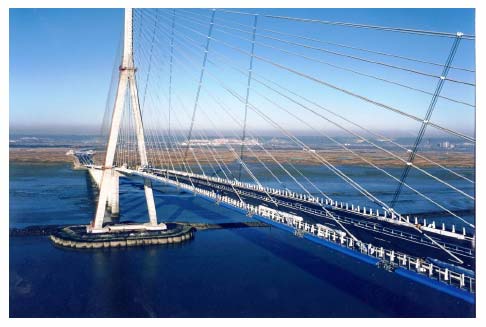
5.1.4 Composite Box Deck
The structural details are similar for the Two Corridor and Single Corridor functional cross sections:
(a) Deck structure
The deck for the composite option is similar in general principles to that of the orthotropic option, except that the orthotropic deck plate is replaced by a conventional reinforced concrete slab.
For the Two Corridor functional cross section, the bottom flange plate thickness typically varies from 12 to 14 mm with trough stiffeners at around 900 mm centres spanning between the cross frame diaphragms. Continuous internal webs are provided at the stay cable anchorages in order to efficiently transfer the stay forces into the section and also to mobilise intermediate diaphragms between stay locations. Two further web elements are located at the edges of the deck to form the edge of the concrete slab.
As for the orthotropic deck, the bottom flange plate thickness is reduced for the Single Corridor functional cross section and is typically 8 mm. For this option the stay cables are anchored on the external webs.
The slab is connected to the webs of the box girder and the flanges of the cross beams by conventional headed shear studs.
For the Two Corridor functional cross section, transverse prestressing of the slab is proposed to improve the in-service behaviour. This will be anchored on the outer webs.
Three options are being considered for the forming of the slab:
- Cast directly onto the box with folding reusable formwork
- Cast directly onto the box using permanent formwork
- Full depth precast slabs shear connected to the steelwork and stitched together
The advantage of reusable formwork is that given the number of re-uses of the forms, it would ordinarily be expected to be the most economic option. However, for the box girder type deck this will be influenced by the required complexity of the form to withdraw it between the transverse bracing members after the slab has been cast. The further development of the layout of the transverse bracing system should consider how the folding forms might be withdrawn.
Given the anticipated complexity of the forms, the relative economy will also be dependent on the number of forms required to keep pace with erection. The width of the deck and the requirement for it to be a box structure will probably result in the steelwork assembly being on critical path. Depending upon where the boxes are assembled and how much space is available it may be that only a limited number of forms are required to keep pace with the steelwork assembly.
Rion Antirion Deck Assembly Lines

Considering the complexity of the re-usable forms, permanent formwork has been considered as an alternative. This has the advantage of minimum initial plant cost. However, there would also be additional costs associated with this formwork which are believed to be likely to outweigh the savings in initial plant costs. Furthermore there would be a weight penalty associated with increased slab thickness required for either precast plank systems such as Omnia or GRP formwork. The knock on costs associated with this would further reduce the economy of the system.
The full depth precast slab option is attractive as installation of the slabs would be faster than the in-situ options and would avoid the cost of the folding forms. This appears to be a valid alternative to re-usable formwork for this deck type and is worthy of further investigation.
(b) Construction modules
As for the orthotropic deck, it is proposed that the segment length is maximised whilst respecting the 127 strand limit for the stay cables. However, the deck will be heavier than the orthotropic option and current studies indicate that the stay cable spacing should be limited to 18 m centres. This leads to typical units which weigh approximately 600 t for the wider Two Corridor configuration (including both the steel and the concrete).
For the transverse system, the same considerations apply as for the orthotropic deck and a braced diaphragm is proposed, in preference to a full plate diaphragm, for overall economy and better internal access. In addition, a plated diaphragm would prevent the use of folding forms for casting the deck as it would obstruct their extraction after casting. It is preferable to maximise the diaphragm spacing, within practical limits for the maximum span of the concrete deck slab achievable with the minimum thickness required for constructability.
Study work carried out to date indicates that the optimum spacing would be 4.0 m which is attainable with a 265 mm slab if considered independent of the erection unit length. However, the number of diaphragms and the diaphragm position in each 18 m unit should be ideally the same so that the stay anchorage is located at the same point in each unit. This allows common formwork to be used in each unit and any strong points for lifting or attachment of gantries will be in the same position in each unit. Consequently 5 diaphragms at 3.6 m spacing is the optimum regular pattern for the 18 m segment length. For this spacing the concrete slab thickness can be reduced to 250 mm.
(c) Edge Detail
The issues relating to the edge detail discussed for the orthotropic steel deck in Section 1.19.3(c) apply equally to this composite box option. There is an additional consideration that a vertical web plate is proposed for the composite deck to form the edge of the slab (and be an end plate for the transverse prestressing in the slab if provided). This further favours the use of a non-structural edge detail.
5.2 Twin Box Girder
The twin box girder is applicable to the Two Corridor functional cross section. The deck arrangement which has been considered is illustrated in Drawing FRC/C/076/D2M/111 in Appendix D.
(a) Construction material
Orthotropic steel box girders
(b) Tower type
Mono-Tower
(c) Stay cable arrangement
The stay cables are anchored at the edge of the deck in a conventional manner which provides significant torsional restraint to the deck when combined with the Mono-Tower (with the upper stay anchorages on a single vertical element). Torsional behaviour of the deck is not a key concern in the scheme development.
(d) Articulation
The deck articulation is as follows:
- Central Tower – monolithic connection
- Flanking Towers – floating system with lateral restraint bearings
- Side Span Piers – guided bearings
- End Piers – guided bearings
Uplift at the side span piers is resisted by vertical tie down cables.
Further study of the articulation will consider two issues:
(i) Floating connection at central tower
The relative cost of a floating connection and monolithic connection at the central tower (with longitudinal buffers or other longitudinal restraint) will be compared. The low maintenance benefits of the monolithic connection would be considered in the comparison.
(ii) Composite counterweight
A composite deck counterweight could be considered instead of the vertical tie down cables as per the single box girder solutions.
(e) Static serviceability
Characteristic values are tabulated below (nominal 1 in 1,000 year return period). Refer to Section 1.19.1(e) for further explanation of the performance data.
Configuration |
Maximum Deflection |
Maximum Twist |
|---|---|---|
Orthotropic Twin Box |
3,800 mm |
1.6 % |
The vertical deflection is similar to the orthotropic single deck but the twist is significantly less due to the additional torsional stiffness provided by anchoring the stay cables at the deck edge.
(f) Aerodynamic performance
Mode |
Orthotropic Twin Box |
|
|---|---|---|
First Symmetric Vertical Mode |
0.302 Hz |
|
First Torsional Mode |
0.600 Hz |
|
Ratio |
1.99 |
Key dynamic modes
The ratio of the modal frequencies is significantly higher than the provisional target ratio of 1.2 required to avoid coupled flutter vibrations.
The central vent provided by the twin deck is expected to improve the aerodynamic performance compared to the single deck solution, As described in Section 1.19.1(f) historic wind tunnel tests carried out for the Setting Forth and Second Severn studies have been used to infer critical wind speeds for the single deck. Historic data for twin decks with wind shields is not available. However, If the non-dimensional parameter is used then the following lower bound critical wind speed is inferred compared to the provisional minimum requirement of approximately 60 m/s.
- Orthotropic Twin Box greater than 100 m/s
(g) Deck structure
The deck consists of a pair of longitudinal girders of relatively traditional orthotropic box construction connected together by discrete cross girders. The fatigue sensitive top flange plate of typically 14 mm thickness is stiffened at 300 mm intervals by longitudinal trough stiffeners (at 600 mm centres) spanning between diaphragms which are required to maintain the shape of the box and provide the transverse framing. The bottom flange plate is typically 8 mm thick stiffened longitudinally by troughs at 900 mm centres.
The main girder cross section has been developed to the profiles shown in the following sketches. The stay cables are anchored along the outside edge, but in the region of the overlapping stay cables, the box has been widened to accommodate the extra stay width. For aesthetic reasons the widened box is maintained throughout the central part of the bridge as discussed in Appendix B.
|
|
Cables anchored on the outside |
Cable lapping region |
The bottom flange is flat and the bottom curve starts at a common setting out point (SOP) with the approach viaducts. The inclination of the inner web was selected to match the angle of the web of the box girder approach span option and also to ensure a reasonable angle for fabrication of the intersection between the longitudinal girders and cross girders. The boxes are spaced at 8 m to provide space for the 7 m wide mono tower. Cross girders are 3 m wide and match the depth of the main box girder.
For typical intermediate diaphragms, a braced structure is proposed in preference to a full plate diaphragm for the reasons described in Section 1.19.3(a). However, plated diaphragms are assumed at the cross girder connections to ensure an adequate connection to the cross girders.
Stay cables are anchored on the external webs, typically at the cross girder locations.
(h) Construction modules
A typical erection unit length of 25 m is proposed as per the single box girder, with stay cables and cross girders also typically at 25 m centres. However, a typical diaphragm spacing of 5.5 m will be combined with a 3.0 m wide cross girder to achieve the 25 m spacing. A fatigue analysis has been carried out to size the top flange stiffening required for the 5.5 m diaphragm spacing.
(i) Edge detail
A non-structural nosing is proposed as per the single box girders (refer Section 1.19.3(c)).
5.3 Ladder Beam
The ladder beam is applicable to either the Two Corridor or the Single Corridor functional cross section. The deck arrangements which have been considered are illustrated in Drawings FRC/C/076/D2M/121 to FRC/C/076/D2M/124 and FRC/C/076/D2M/141 in Appendix D.
Ladder beam decks typically feature two parallel longitudinal steel girders at the edges of the deck which are connected by steel cross girders at regular intervals. In the Multi-Modal Scheme Assessment this type of deck structure was not considered due to requirement for a very wide deck. With the D2M functional cross section this type of deck structure becomes worthy of investigation.
Ching Chau Min Jiang Bridge, Fuzhou, China

The world’s longest ladder deck span is 605 m, a record held by the Ching Chau Min Jiang Bridge in Fuzhou, China. A number of other long span composite plate ladder beam decks have also been constructed as noted below.
- Ching Chau Min Jiang Bridge, China (2001) – main span 605 m
- Yang Pu Bridge Shanghai, China (1993) – main span 602 m
- Rion Antirion Bridge, Greece (2004) – multiple cable stayed spans of 550 m
- Ting Kau Bridge, Hong Kong (1998) – double main spans of up to 475 m
- Second Severn Crossing, UK (1996) – main span with wind shields 456 m
The longest span achieved which includes wind shields is the Second Severn Crossing at 456 m. However, the tower of the Second Severn is an H-Shape which does not provide as much torsional restraint to the deck as a Diamond or A-Frame tower (a phenomenon described in Section 1.24.2(a)). Furthermore, the Second Severn does not include fairings which might be expected to improve the aerodynamic performance. With the critical wind speed of the site being similar to that of the Firth of Forth there is an indication that aerodynamic stability of a ladder deck with wind shields could be achieved at a longer span.
Second Severn Crossing, UK
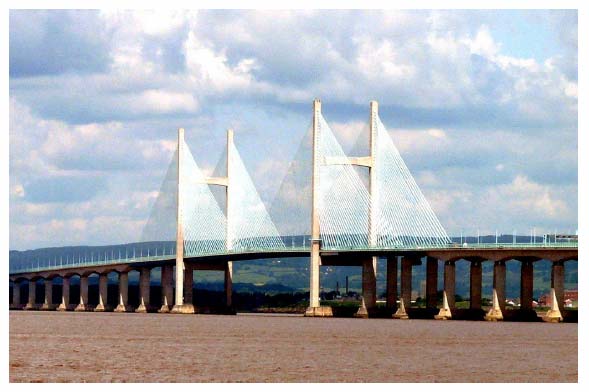
For the Two Corridor functional cross section, the gap between the carriageways is intended to be used to provide a vented slot. Based on aerodynamic studies for other bridges such as Ting Kau, Stonecutters Bridge and Messina Bridge, this has been shown to significantly improve the aerodynamic performance of bridges. The gap does not necessarily need to be maintained over the entire length of the main span and it is possible that the concrete slab could be full width close to the towers to more efficiently carry forces due to wind as well as to provide additional sectional area to resist the compressive forces in the deck.
Ting Kau Bridge, Hong Kong
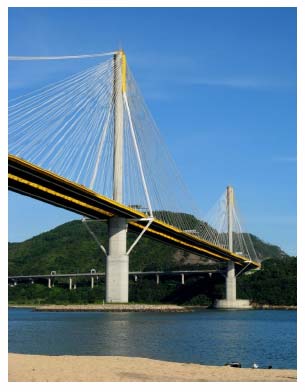
5.3.1 Review of historic aerodynamic data
(a) Unvented decks
Limited information is available regarding the tests undertaken on the Second Severn Crossing as part of the design development. In general the tests that were undertaken are applicable to the unvented deck proposed for the Single Corridor ladder deck scheme as they relate to an open plate girder solution with wind barriers of approximately 50% porosity. In summary these tests demonstrated adequate performance of the section up to wind speeds of around 60 m/s. This deck section, as tested, did not include an aerodynamic fairing. The key parameters for the Second Severn deck section are ft = 0.46 Hz, B = 35 m which suggests a reduced velocity Uc = 3.76 x B x ft.
Whilst no details of the testing are available, published literature indicates that the critical wind speed for the YangPu cable stayed bridge in Shanghai was around 80 m/s (ladder beam deck with a main span of 605 m and ft= 0.517 Hz, fb = 0.078 Hz, B = 32.5 m). This suggests a reduced velocity Uc = 4.76 x B x ft.
(b) Vented decks
A typical cross section for Ting Kau Bridge is shown below. In summary the ladder deck cross section consists of plate girders with a composite deck slab and includes a vented slot between the carriageways. The overall deck width is 42.8 m with a central slot 5.3 m wide. Extensive tests were undertaken on the basic section shown as well as sections that included aerodynamic fairings that increased the critical wind speed for the onset of divergent oscillations.
Ting Kau Bridge Cross Section

Whilst it would not be appropriate to draw firm conclusions from the results of the Ting Kau Bridge tests it is interesting to note that the dynamic properties of the final design were fb = 0.132 Hz, ft = 0.408 Hz and that with a deck width of 43 m and a deck weight of around 40 tonnes/m the deck was proven to be stable in wind speeds up to 88 m/s without deck fairings and 101 m/s with fairings. This is indicative of a reduced velocity
Uc = 5.01 x B x ft. without fairings and Uc = 5.75 x B x ft. with fairings.
(c) Summary
The results are presented below. The reduced velocity for the onset of torsional galloping prescribed by BD 49/01 "Design Rules for Aerodynamic Effects on Bridges" for a plate or box girder ladder deck without a fairing is also presented for comparison.
Bridge |
Vent |
Wind Shields |
Fairings / Profiled Edge Detail |
Reduced Velocity |
|---|---|---|---|---|
BD49/01 |
No |
No |
No |
3.30 |
Second Severn |
No |
Yes |
No |
3.76 |
Yang Pu |
No |
No |
Yes |
4.76 |
Ting Kau |
Yes |
No |
No |
5.01 |
Ting Kau |
Yes |
No |
Yes |
5.76 |
The results from the Second Severn Crossing are applicable to the Single Corridor functional cross section and a reduced velocity of 3.75 is tentatively assumed. Although it is anticipated that a fairing will improve the aerodynamic performance it is prudent to be conservative in advance of wind tunnel testing.
For the Two Corridor functional cross section there is no directly relevant historic data for the case with a vent and wind shields. However, a reduced velocity of 4.5 is tentatively assumed considering the range of data tabulated above.
5.3.2 Two Corridor Option
(a) Construction material
Composite ladder deck with box beams or plate girders
(b) Tower type
Mono-Tower
(c) Stay cable arrangement
The stay cables are anchored at the edge of the deck in a conventional manner in order to provide the requisite torsional stiffness to the deck.
(d) Articulation
The deck articulation is as follows:
- Central Tower – monolithic connection
- Flanking Towers – floating system with lateral restraint bearings
- Side Span Piers – guided bearings
- End Piers – guided bearings
Uplift at the side span piers is resisted by vertical tie down cables.
(e) Static serviceability
Characteristic values are tabulated below (nominal 1 in 1,000 year return period). Refer to Section 1.19.1(e) for further explanation of the performance data.
Configuration |
Maximum Deflection |
Maximum Twist |
|---|---|---|
Mono-Tower ladder beam |
3,060 mm |
1.2 % |
(f) Aerodynamic performance
The fundamental frequencies for the plate girder option are given below:
Mode |
Mono-tower |
|
|---|---|---|
First Symmetric Vertical Mode |
0.195 Hz |
|
First Torsional Mode |
0.440 Hz |
|
Ratio |
2.26 |
Key dynamic modes
The ratio of the modal frequencies is significantly higher than the provisional target ratio of 1.2 required to avoid coupled flutter vibrations.
The width of the Two Corridor option is similar to Ting Kau Bridge. However, the wind shields on the structure will have a detrimental effect on stability compared to Ting Kau and a tentative estimate of the reduced velocity has been made as described in Section 1.21.1 above. Based on a deck width of 43 m, the inferred critical wind speed is:
- Mono-Tower ladder beam 85 m/s
However, as described in Appendix B interaction has been observed between the tower lateral modes and deck torsion which could potentially adversely affect the aerodynamic performance. This will need careful study and will require wind tunnel testing over a range of frequency ratios.
(g) Deck structure
Conventional ladder deck layouts would utilise transverse girders at around 3 - 4 m centres with a constant depth reinforced concrete deck slab. Due to the vented area at the bridge centreline, pairs of primary transverse girders span 40 m between longitudinal girders at the stay cable locations, but smaller secondary cross girders span to longitudinal stringers which frame the vents.
Another option under consideration consists of uniform cross girders spanning between longitudinal girders, with smaller vents between each cross girder. However, the aerodynamic influence of these small vents may not be as effective as the larger vents. Wind tunnel studies are required to confirm the aerodynamic behaviour.
Two options for the longitudinal girders have been investigated. The first option utilises box girder sections for the main longitudinal beams and the second utilises plate girders in lieu of box girders, primarily in order to reduce the complexity and hence the cost of the fabricated steel deck. Some maintenance disadvantages are introduced with the plate girder scheme in terms of increased complexity of the steelwork surfaces to be maintained and elimination of a secure enclosed access route below deck which could be provided within the box girders.
The slab thickness is typically 260 mm, deepening over the longitudinal girders.
For the plate girder option, the 3.0 m deep longitudinal girders have a typical web thickness of 30 mm and a bottom flange varying from 1,300 x 55 mm in the mid span to 2,500 x 125 mm at the towers. The top flange is constant at 600 x 30 mm.
(h) Construction module
As for the composite box girders, an erection unit length of 18 m has been assumed with cross girders typically based on a 3.6 m module.
(i) Edge detail
Both the box beam and plate girder solutions include a fairing on the edges of the deck.
This fairing serves the following purposes:
- It defines a streamlined geometry to the leading edge of the deck which is expected to reduce overall drag forces on the bridge deck and improve aerodynamic performance.
- Encloses the edge of the bridge deck thereby providing a smooth uninterrupted and largely self cleaning deck edge that would otherwise be more difficult to maintain.
- In particular it encloses the stay anchorages thereby protecting these critical elements that would otherwise be more vulnerable and more difficult to maintain.
- Provides an aesthetically pleasing and superior finish to deck edge that would otherwise look industrial.
5.3.3 Single Corridor Option
(a) Construction material
Composite ladder deck with box beams or plate girders
(b) Tower type
Diamond Tower or A-Frame Tower
(c) Stay cable arrangement
As for the Two Corridor option, the stay cables are anchored at the edge of the deck to provide sufficient torsional stiffness to the deck. The upper stay anchorages are anchored on or close to the tower centreline in order to ensure that the double main span effect does not compromise the torsional stiffness of the system (refer to Section 1.24.2(a)). The towers considered have upper sections which consist of either a single leg or two legs rigidly connected together.
(d) Articulation
The deck articulation is as follows:
- Central Tower – monolithic connection
- Flanking Towers – floating system with lateral restraint bearings
- Side Span Piers – guided bearings
- End Piers – guided bearings
Uplift at the side span piers is resisted by vertical tie down cables.
(e) Static serviceability
Characteristic values are tabulated below (nominal 1 in 1,000 year return period). Refer to Section 1.19.1(e) for further explanation of the performance data.
Configuration |
Maximum Deflection |
Maximum Twist |
|---|---|---|
Diamond Tower ladder beam |
3,140 mm |
1.60% |
A-Frame Tower ladder beam |
3,120 mm |
1.55% |
(f) Aerodynamic performance
The fundamental frequencies for the plate girder option are given below:
Mode |
Diamond Tower |
A-Frame Tower |
|
|---|---|---|---|
First Symmetric Vertical Mode |
0.235 Hz |
0.235 Hz |
|
First Torsional Mode |
0.426 Hz |
0.413 Hz |
|
Ratio |
1.81 |
1.76 |
Key dynamic modes
The ratio of the modal frequencies is significantly higher than the provisional target ratio of 1.2 required to avoid coupled flutter vibrations.
The functional width of the Single Corridor option is very similar to the Second Severn Crossing. However, despite the span being over 40% longer, the torsional frequency is only reduced by approximately 10% due to the more efficient torsional support provided by the stay system when combined with a Diamond or A-Frame tower. The overall deck width of the Forth Replacement Crossing is a little wider due to the aerodynamic nosing and based on a deck width of 39 m, the tentative reduced velocity established from the results available for the Second Severn Crossing (described in Section 1.21.1 above) gives the following estimates of the likely divergent wind speeds:
- Diamond Tower ladder beam 62 m/s
- A-Frame Tower ladder beam 60 m/s
These speeds are close to the provisional minimum critical wind speed of 60 m/s. However, as noted in Section 1.21.1, this is a conservative estimate since the incorporation of an aerodynamic nosing or fairing is expected to increase the critical wind speed, not just because of the increased width but also because of the more aerodynamic shape. These results do underline the importance of modelling several options of edge detail during preliminary section model wind tunnel tests in order to achieve the best performance.
It is worth noting that the effect of introducing torsionally stiff boxes in lieu of plate girders for the longitudinal deck beams has a small beneficial effect in terms of increasing the frequency of the first torsion mode. For one of the early diamond tower schemes investigated, replacing the longitudinal plate girders with box sections was found to increase the first torsion frequency by around 7% thus confirming that torsional stiffness is driven by the stay cables and the tower rather than the deck. This would increase the critical wind speed by a similar amount.
(g) Deck structure
The deck has a conventional ladder deck layout with transverse girders at 3.6 m centres and a constant depth reinforced concrete deck slab. However, the pairs of primary transverse girders at stay cable locations are deeper than the intermediate cross girders to provide the required stiffness. The transverse spacing between longitudinal girders is 28 m.
The slab thickness is typically 260 mm, deepening over the longitudinal girders.
As for the Two Corridor option, both box girders and plate girders have been considered for the longitudinal girders.
For the plate girder option, the 3.0 m deep longitudinal girders have a typical web thickness of 30 mm and a bottom flange varying from 1,300 x 55 mm in the mid span to 2,500 x 125 mm at the towers. The top flange is constant at 600 x 30 mm.
(h) Construction module
As for the composite box girders, an erection unit length of 18 m has been assumed with cross girders typically based on a 3.6 m module.
(i) Edge detail
A fairing is provided for the reasons described in Section 1.21.2(i).
